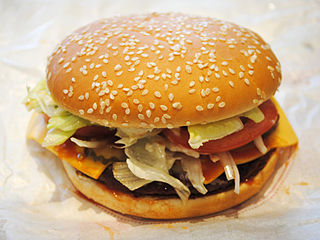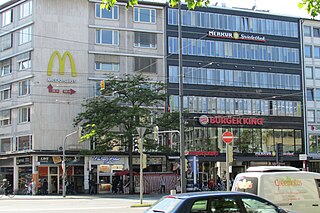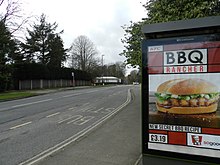
Advertising is the practice and techniques employed to bring attention to a product or service. Advertising aims to put a product or service in the spotlight in hopes of drawing it attention from consumers. It is typically used to promote a specific good or service, but there are wide range of uses, the most common being the commercial advertisement.

A fast-food restaurant, also known as a quick-service restaurant (QSR) within the industry, is a specific type of restaurant that serves fast-food cuisine and has minimal table service. The food served in fast-food restaurants is typically part of a "meat-sweet diet", offered from a limited menu, cooked in bulk in advance and kept hot, finished and packaged to order, and usually available for take away, though seating may be provided. Fast-food restaurants are typically part of a restaurant chain or franchise operation that provides standardized ingredients and/or partially prepared foods and supplies to each restaurant through controlled supply channels. The term "fast food" was recognized in a dictionary by Merriam–Webster in 1951.

"Junk food" is a term used to describe food that is high in calories from sugar and/or fat, and possibly sodium, making it hyperpalatable, but with little dietary fiber, protein, vitamins, minerals, or other important forms of nutritional value. It is also known as HFSS food. The term junk food is a pejorative dating back to the 1950s. Many variations of junk food can be easily found in most supermarkets and fast food restaurants. Due to easy accessibility, commercially-oriented packaging, and often-low prices, people are most likely to consume it.

A television advertisement is a span of television programming produced and paid for by an organization. It conveys a message promoting, and aiming to market, a product, service or idea. Advertisers and marketers may refer to television commercials as TVCs.

Fast food is a type of mass-produced food designed for commercial resale, with a strong priority placed on speed of service. It is a commercial term, limited to food sold in a restaurant or store with frozen, preheated or precooked ingredients and served in packaging for take-out/takeaway. Fast food was created as a commercial strategy to accommodate large numbers of busy commuters, travelers and wage workers. In 2018, the fast food industry was worth an estimated $570 billion globally.
McDonald's maintains an extensive advertising campaign. In addition to the usual media such as television, radio and newspaper ads, the company makes significant use of billboards and signage, and sponsors sporting events ranging from Little League to the FIFA World Cup and Olympic Games. The company also makes coolers of orange drink with their logo available for local events of all kinds. However, television ads remain the primary form of advertisement.
Advertising in video games is the integration of advertising into video games to promote products, organizations, or viewpoints.

The Whopper is the signature hamburger and an associated product line sold by the international fast food restaurant chain Burger King and its Australian franchise Hungry Jack's. Introduced in 1957, the hamburger has undergone several reformulations, including changes to portion size and bread used. The hamburger is well known in the fast food industry, with Burger King advertising itself as "the Home of the Whopper" and naming its kiosk stores the BK Whopper Bar. In response to the Whopper, Burger King's competitors have developed similar products designed to compete against it.

The Burger King is a king character used as the primary mascot for the fast-food restaurant chain of the same name. The first iteration of the Burger King was part of a sign at the first Burger King restaurant in Miami, Florida, in 1955. Later signs showed the King sitting on a "burger throne" as well as atop the BK sign while holding a beverage. In the early 1970s, Burger King started using a small and animated version of the King in its children's advertising, voiced by Allen Swift. In 1976, the original animated King was replaced by the "Marvelous Magical Burger King" which was a red-bearded and Tudor-era king who ruled the Burger King Kingdom and performed magic tricks that were mostly sleight-of-hand but sometimes relied on camera tricks or involved his "Magic Ring" which could summon copious amounts of food. The Burger King Kingdom advertisements were discontinued in the late 1980s in favor of the BK Kids Club Gang and other advertising programs.

The Big King sandwich is one of the major hamburger products sold by the international fast-food restaurant chain Burger King, and was part of its menu for more than twenty years. As of March 2019, it is sold in the United States under its 1997 Big King XL formulation. During its testing phase in 1996–1997, it was originally called the Double Supreme and was configured similarly to the McDonald's Big Mac—including a three-piece roll. It was later reformulated as a more standard double burger during the latter part of product testing in 1997. It was given its current name when the product was formally introduced in September 1997, but maintained the more conventional double cheeseburger format.

BK Tee Vee was Burger King's MTV-inspired advertising campaign from 1991 to 1993.
Since it was founded in 1954, international fast food chain Burger King has employed many advertising programs. During the 1970s, its advertisements included a memorable jingle, the inspiration for its current mascot the Burger King and several well-known and parodied slogans, such as Have it your way and It takes two hands to handle a Whopper. From the early 1980s until approximately 2002, Burger King engaged a series of advertising agencies that produced many unsuccessful slogans and programs, including its least successful campaign, Where's Herb?.

The kids' meal or children's meal is a fast food combination meal tailored to and marketed to children. Most kids' meals come in colorful bags or cardboard boxes with depictions of activities/games on the bag or box and a toy inside. Most standard kids' meals comprise a burger or chicken nuggets, a side item, and a soft drink.
Advertising to children refers to the act of advertising products or services to children as defined by national laws and advertising standards.

The Burger wars are a series of off-and-on comparative advertising campaigns consisting of mutually-targeted advertisements that highlight the intense competition between hamburger fast food chains McDonald's, Wendy's, Burger King and others in the United States. The term first came into use during the late 1970s due to an attempt by Burger King to generate increased market and mind-share by attacking the size of bigger rival McDonald's hamburgers.
Advertising is a form of selling a product to a certain audience in which communication is intended to persuade an audience to purchase products, ideals or services regardless of whether they want or need them. While advertising can be seen as a way to inform the audience about a certain product or idea it also comes with a cost because the sellers have to find a way to show the seller interest in their product. It is not without social costs. Unsolicited commercial email and other forms of spam have become so prevalent that they are a major nuisance to internet users, as well as being a financial burden on internet service providers. Advertising increasingly invades public spaces, such as schools, which some critics argue is a form of child exploitation. Advertising frequently uses psychological pressure on the intended consumer, which may be harmful. As a result of these criticisms, the advertising industry has seen low approval rates in surveys and negative cultural portrayals.
"Pester power", or "the nag factor", as the phenomenon is known in U.S. literature, is the "tendency of children, who are bombarded with marketers' messages, to unrelentingly request advertised items". The phrase is used to describe the negative connotations of children's influence in their parents' buying habits.
The United States food and beverage industry has increased the amount of advertising that intensively and aggressively targets children through multiple channels. Food marketers know that the youth consumers have equal if not more spending power than adults, they hold purchasing influence, and have the potential to be lifelong consumers. The advertisements for products predominantly high in sugar and fat have increased and have had an effect on the major health epidemic in the US of Childhood obesity, and as such are inconsistent with national dietary recommendations. Food advertisements have moved from the television into the classroom. Marketing companies are exploring new creative techniques to reach their target audience, young children, through promotions, contests, and incentive programs. As a result, the US has progressively been placing regulations on how much advertising is allowed during children's programming.
Advertisements in schools is a controversial issue that is debated in the United States. Naming rights of sports stadiums and fields, sponsorship of sports teams, placement of signage, vending machine product selection and placement, and free products that children can take home or keep at school are all prominent forms of advertisements in schools.











